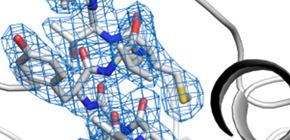
Medium for delivering protein crystals with low damage discovered
A step toward the development of new drugs through crystal structure analysis of proteins
Special Researcher SUGAHARA Michihiro (SACLA Science Research Group, SPring-8 Center, RIKEN), Group Director IWATA So (Professor, Graduate School of Medicine, Kyoto University), and Associate Professor SUZUKI Mamoru (Laboratory of Protein Information, Research Center for State-of-the-Art Functional Protein Analysis, Institute for Protein Research, Osaka University) found that hyaluronic acid could be used as a medium for delivering protein crystals in Serial Femtosecond Crystallography (SFX) using X-ray lasers at the X-ray Free Electron Laser facility SACLA.
The use of hyaluronic acid can solve the problem of radiation damage to samples in SFX using X-ray lasers at SACLA. Even in the case of minute protein crystals, it’s possible to determine 3D structure of various proteins by consuming a small amount of sample.
In 2014, this joint research group developed the grease matrix method for performing X-ray analysis of protein crystals by slowly ejecting a small amount of protein crystals mixed with high-viscosity grease from injectors. Compared with conventional liquid jet methods for ejecting liquid samples (liquid samples containing crystals from 10~100mg proteins) from injectors, the grease matrix method reduced the amount of protein crystals necessary for diffraction experiments to between one-tenth and one-hundredth (the amount of used protein reduced to 1mg or less). However, the grease matrix method had a problem; when grease and protein crystals were mixed, crystals in some samples displayed cracks or melted.
This joint group solved this problem by using hyaluronic acid aqueous solution as a medium for delivering protein crystals. The use of hyaluronic acid and grease according to the sample in a complementary way will make it possible to perform crystal structure analysis of various proteins as drug targets.
Abstract
The grease matrix was originally introduced as a microcrystal-carrier for serial femtosecond crystallography and has been expanded to applications for various types of proteins, including membrane proteins. However, the grease-based matrix has limited application for oil-sensitive proteins. Here we introduce a grease-free, water-based hyaluronic acid matrix. Applications for proteinase K and lysozyme proteins were able to produce electron density maps at 2.3-Å resolution.

To learn more about this research, please view the full research report entitled " Oil-free hyaluronic acid matrix for serial femtosecond crystallography " at this page of the Scientific Reports website.
Related link
